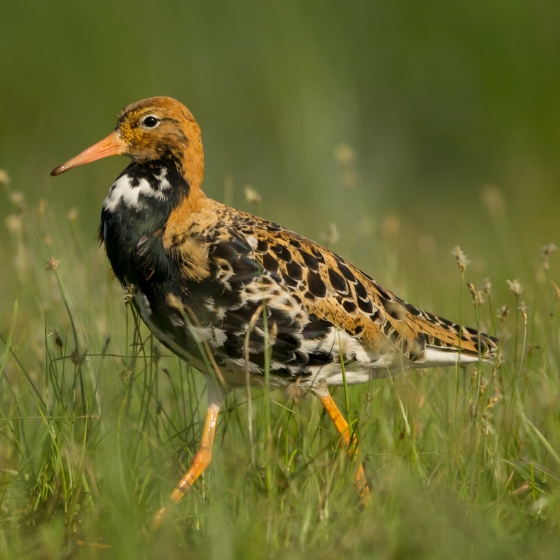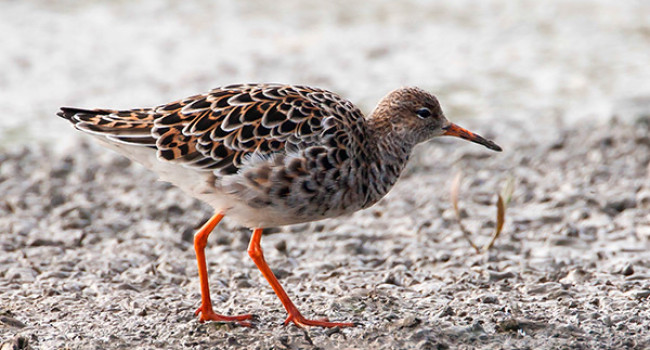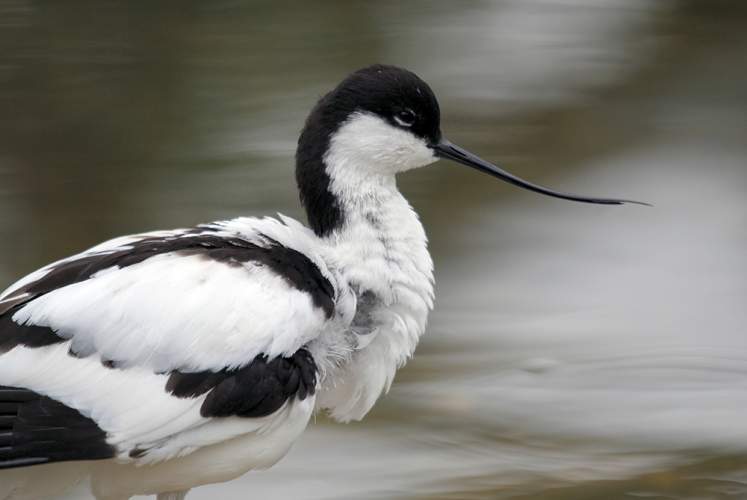Ruff
Calidris pugnax (Linnaeus, 1758)
RU
 RUFF.
RUFF.  5170
5170

Family: Charadriiformes > Scolopacidae

This medium-sized wader can seem ungainly, with its short bill, small head and a halting gait. Sightings logged through BirdTrack reveal that Ruff can be encountered throughout the year, although highest numbers occur in early August, when migration occurs.
Summer plumage is a varied affair in Ruff, with richly-mottled earthy colours and a feathery collar of either russet, black or white, giving rise to their name. Males display communally in front of females at sites known as ‘leks’.
In autumn, the Ouse Washes and the nearby Norfolk coast hold the largest concentrations of Ruff, including smart gingery juvenile birds, which can be seen feeding in marshes and wet fields, sometimes accompanying plovers on bare arable land.
Identification
Ruff identification is sometimes difficult. The following article may help when identifying Ruff.
Identifying Ruff

Ruff, with their variable size and plumage, often present identification issues. However, by learning how to recognise Ruff in their various guises through this video, you’ll be able to pick them out with confidence, and have a great reference point for identifying other similar-looking waders.
Develop your bird ID skills with our training courses
Our interactive online courses are a great way to develop your bird identification skills, whether you're new to the hobby or a competent birder looking to hone your abilities.
Browse training coursesStatus and Trends
Population size and trends and patterns of distribution based on BTO surveys and atlases with data collected by BTO volunteers.
CONSERVATION STATUS
This species can be found on the following statutory and conservation listings and schedules.
POPULATION CHANGE
This species was once a more common breeding species in the UK but substantial declines occurred in the 18th and 19th centuries (Birds of England) since when Ruff has been a scarce breeding species. More recently, RBBP figures indicate that the Ruff has suffered a strong decline in breeding numbers in the 25 years to 2019, with a five-year mean of 13 females in the period 2015–2019; the UK range has shifted northwards with most breeding records now coming from Scotland (Eaton et al. 2021).
DISTRIBUTION
In winter, Ruffs are found at inland and coastal locations, predominantly in England, and are scarce elsewhere. They are very scarce breeders in Britain. Fenland remains a favoured area, but elsewhere breeding is now confined to northwest England and the Hebrides.
Occupied 10-km squares in UK
| No. occupied in breeding season | 16 |
| % occupied in breeding season | 0.5 |
| No. occupied in winter | 274 |
| % occupied in winter | 9.1 |
European Distribution Map
DISTRIBUTION CHANGE
Change in occupied 10-km squares in the UK
| % change in range in breeding season (1968–72 to 2008–11) | +14.3% |
| % change in range in winter (1981–84 to 2007–11) | +12.4% |
SEASONALITY
Ruffs are recorded year-round though with a strong peak during autumn migration.

Movement
Information about movement and migration based on online bird portals (e.g. BirdTrack), Ringing schemes and tracking studies.
An overview of year-round movements for the whole of Europe can be seen on the EuroBirdPortal viewer.
RINGING RECOVERIES
View a summary of recoveries in the Online Ringing Report.
Foreign locations of birds ringed or recovered in Britain & Ireland

Biology
Lifecycle and body size information about Ruff, including statistics on nesting, eggs and lifespan based on BTO ringing and nest recording data.
SURVIVAL & LONGEVITY
View number ringed each year in the Online Ringing Report
Maximum Age from Ringing 
|
9 years 0 months 25 days (set in 1986) 
|
Typical Lifespan 
|
4 years with breeding typically at 2 year |
Adult Survival 
|
0.524±0.036 (Male: 0.524± Female: 0.524±)  
|
BIOMETRICS
| Juveniles | 169.4±15.9 | Range 152-194mm, N=69 |
| Juveniles | 137±43.2 | Range 85.0–215g, N=61 |
Feather measurements and photos on featherbase 
CODES & CLASSIFICATION
Ring size 
|
C (females) or D (male and pulli) |
Field Codes 
|
2-letter: RU | 5-letter code: RUFF. | Euring: 5170 |
For information in another language (where available) click on a linked name
Research
Interpretation and scientific publications about Ruff from BTO scientists.
CAUSES AND SOLUTIONS
Causes of change
The decline in UK since 1970s mirrors the pattern shown in larger populations across Europe (Keller et al. 2020). There has also been a change of migration route with most of the main population from Russia now migrating through Belarus rather than western Europe(Rakhimberdiev et al. 2011, Verkuil et al. 2012). This change is believed to have been caused by a deterioration in the quality of staging sites in the Netherlands and, as a consequence of the reduced numbers of passage birds, a long-term recovery in the number of breeding Ruff in the UK is considered unlikely even if suitable habitat exists in the UK.
PUBLICATIONS (2)

Consequences of population change for local abundance and site occupancy of wintering waterbirds
Wavering Waterbirds
Protected sites are assigned based on population statistics for vulnerable and endangered species. This new study using WeBS data shows that changes in population size can affect local abundance, and thus influence whether or not key targets are met for site protection.
Sex differences in the migration, moult and wintering areas of British-ringed Ruff
Links to more studies from ConservationEvidence.com
- Use of Willapa Bay, Washington, by shorebirds and waterfowl after Spartina control efforts
- Rush cutting to create nesting patches for lapwings Vanellus vanellus and other waders, Lower Lough Erne RSPB reserve, County Fermanagh, Northern Ireland
- Is the density of redshank Tringa totanus nesting on saltmarshes in Great Britain declining due to changes in grazing management?
Would you like to search for another species?












Share this page